 Open Access
Open Access
ARTICLE
A Novel IoT Architecture, Assessment of Threats and Their Classification with Machine Learning Solutions
1 Department of Computer Science and Engineering, Institute of Engineering & Management, Kolkata, 700091, India
2 Department of Information Technology, RCC Institute of Information Technology, Kolkata, 700015, India
3 Department of AK Choudhury, School of Information Technology, University of Calcutta, Kolkata, 700098, India
4 Department of Computer Science, Surendranath Evening College, University of Calcutta, Kolkata, 700009, India
* Corresponding Author: Himadri Nath Saha. Email:
Journal on Internet of Things 2023, 5, 13-43. https://doi.org/10.32604/jiot.2023.039391
Received 26 January 2023; Accepted 04 May 2023; Issue published 22 September 2023
Abstract
The Internet of Things (IoT) will significantly impact our social and economic lives in the near future. Many Internet of Things (IoT) applications aim to automate multiple tasks so inactive physical objects can behave independently of others. IoT devices, however, are also vulnerable, mostly because they lack the essential built-in security to thwart attackers. It is essential to perform the necessary adjustments in the structure of the IoT systems in order to create an end-to-end secure IoT environment. As a result, the IoT designs that are now in use do not completely support all of the advancements that have been made to include sophisticated features in IoT, such as Cloud computing, machine learning techniques, and lightweight encryption techniques. This paper presents a detailed analysis of the security requirements, attack surfaces, and security solutions available for IoT networks and suggests an innovative IoT architecture. The Seven-Layer Architecture in IoT provides decent attack detection accuracy. According to the level of risk they pose, the security threats in each of these layers have been properly categorized, and the essential evaluation criteria have been developed to evaluate the various threats. Also, Machine Learning algorithms like Random Forest and Support Vector Machines, etc., and Deep Learning algorithms like Artificial Neural Networks, Q Learning models, etc., are implemented to overcome the most damaging threats posing security breaches to the different IoT architecture layers.Keywords
The Internet of Things (IoT) enables the installation of billions of linked devices virtually anywhere on Earth [1]. IoT applications are essential in the current environment as they reduce the need for human effort in many parts of life, promote effective resource utilization, ensure high-quality data, etc. [2]. IoT devices are capable of collecting huge volumes of temperature, pressure, and distance proximity data using sensors from different Healthcare, Agricultural domains, etc. Therefore, IoT applications have been deployed in Smart Agriculture [3–6], Home Automation [7–10], Smart Cities [11–14], Smart Healthcare [15–17], and so on [18–20].
IoT devices have grown incredibly vulnerable to assaults and security breaches due to the widespread use of IoT applications [21–26]. From a security perspective, managing the IoT’s enormous scale, which has grown at an exponential rate over time, has been a crucial problem. The current security mechanisms and technologies are not built to scale to billions of devices [27,28]. It is challenging to define uniform protection techniques and procedures for IoT devices since they frequently use various transmission technologies [29,30]. Threats to the IoT environment are primarily posed by the human element. Providing extensive information about ourselves, our company, and our residence could potentially be a weakness if any of this data is accessible to fraudulent users or other undesirable third parties [31,32]. In spite of this, the Application framework of IoT devices is entirely diverse and dynamic due to the unpredictable mobility of the devices, which causes unexpected changes to their communication capabilities and position over time [33].
Dealing with serious IoT security issues is now more important than ever because IoT will soon permeate every aspect of our lives and be accessed from anywhere [34–38]. In order to build such a society in an ever-increasing way, it is vital to have strong security, proper confidentiality, authenticity, and attack recovery. It is crucial to implement the essential changes in the architecture of the IoT applications to attain end-to-end secure IoT environments [39]. Undoubtedly, the impending IoT concerns will necessitate a new secure-by-design perspective, in which risks will be dealt with dynamically as IoT devices will learn to adapt to attacks in a number of different ways [40]. IoT technology has many advanced qualities such as safety, communication, intelligence, and scalability; though Machine Learning (ML) algorithms [41], and lightweight encryption techniques [42], the existing architectures in IoT [43,44] are not able to recognize all these types of features at a time. The above-mentioned factors have motivated us to write this article.
In this paper, the existing layer architectures are modified and a new Seven-Layered Architecture has been proposed which when implemented achieves a high attack detection accuracy. This work provides an array of contributions, including:
i) A new Seven Layer Secure-by-design Architecture has been proposed for the first time after extensive research work on the various existing layered architectures in IoT for security are studied.
ii) Assessment metrics of security threats are being performed to categorize the attacks according to the probability of their occurrence from high to low and the effects on the Internet of Things systems from high to low.
iii) The impact of IoT security in terms of confidentiality, availability, and integrity of any IoT system.
iv) The attacks occurring in these layers have been presented and categorized from the most dangerous to the least dangerous ones based on various parameters such as the probability of occurrence and the impression it has on the IoT applications.
v) Solutions with Machine Learning (ML), Deep Learning (DL), and Reinforcement Learning algorithms (RL) have been thoroughly discussed with the capability of detecting and mitigating a range of attacks.
vi) Furthermore, we presented the feasibility of ML, DL, and RL algorithms in terms of time and space complexities and prediction accuracy.
vii) After extensive study of the literature, we have provided a direction for future research.
The following sections make up the remainder of this article: Section 2 depicts the Layered architectures in IoT and highlights the new proposed architecture. Section 3 portrays the proposed seven-layered IOT architecture. Section 4 depicts the assessment of various attacks from high to low. In Section 5, the attacks occurring in these layers according to their vulnerability are depicted. In Section 6, Machine Learning and Deep Learning techniques have been outlined to alleviate a range of assaults occurring in multiple attacks. Further, in Section 7, the ML and DL algorithms have been evaluated extensively based on their performance, the cost (time and space complexities), and the accuracy of prediction, to see if they are feasible to be implemented. Section 5 highlights what is to be deployed for IoT security.
The future works are discussed in Section 7 and the conclusion has been enlisted in Section 8.
2 Proposed Seven-Layer Architectures in IoT
There have been numerous layered architectures for the Internet of Things proposed, including three, four, five, and six-layered systems. The core concept of IoT is fulfilled by three-layer architecture [45,46], which has a very simple architecture. It was put forth while the Internet of Things was just being started, but it fell short of meeting all of its requirements. Cloud, data center, API, and Web Services were not prioritized in the previous architecture. As a result, the middleware layer, which consists of the API, Web services, data center, and cloud, was introduced and the four-layered architecture [31,45–47] was suggested. Five-layer design [32,39] was suggested because there were still some security and storage concerns. The business layer, which is the new layer, is in charge of managing business values, the entire IoT network, and data confidentiality. The five-layer architecture’s inability to address every security risk prompted the development of a six-layer architecture [45], which included the Security Layer. Even when the Security Layer has been introduced, additional security checks are still necessary to boost the IoT network’s security and make it more dependable and accessible. The future path of IOT security will be determined by the development of a high-quality architecture to enable dependable and cryptographically secure from the perception layer to the application layer [48]. The specifications and implementation of machine learning and lightweight encryption algorithms that meet the improvements in IOT applications make up the second factor. As a result, the existing IoT architectures do not support all the developments needed to add new sophisticated features to IoT, such as IoT data, Machine Learning techniques [49], and light encryption algorithms. The seven-layered IoT method can lead to high assault detection accuracy. As a result, we have suggested the seven-layer design, a revolutionary IoT ecosystem. The Perception Layer, Data Pre-processing Layer, Network Layer, Middleware Layer, Data Storage and Big Data Analysis Layer, Application Layer, and Business Layer make up the seven layers of the architecture.
IoT equipment produces massive amounts of data very quickly. This suggested architecture features a layer to manage massive volumes of data, which solves the problem of processing “Big Data”. In order to store both non-structured and structured IoT data, this suggested architecture comprises a framework based on data storage. The Hadoop framework and a number of other databases are used in the innovative design to manage the data that the sensors and actuators collect in the Perception Layer. To stay up with current concerns and technology, this new design relies on big data and machine learning as its core components. Fig. 1 shows the layers that make up the seven-layer design. The new IoT seven-layer design is shown in Table 1 along with the main responsibilities of each layer.
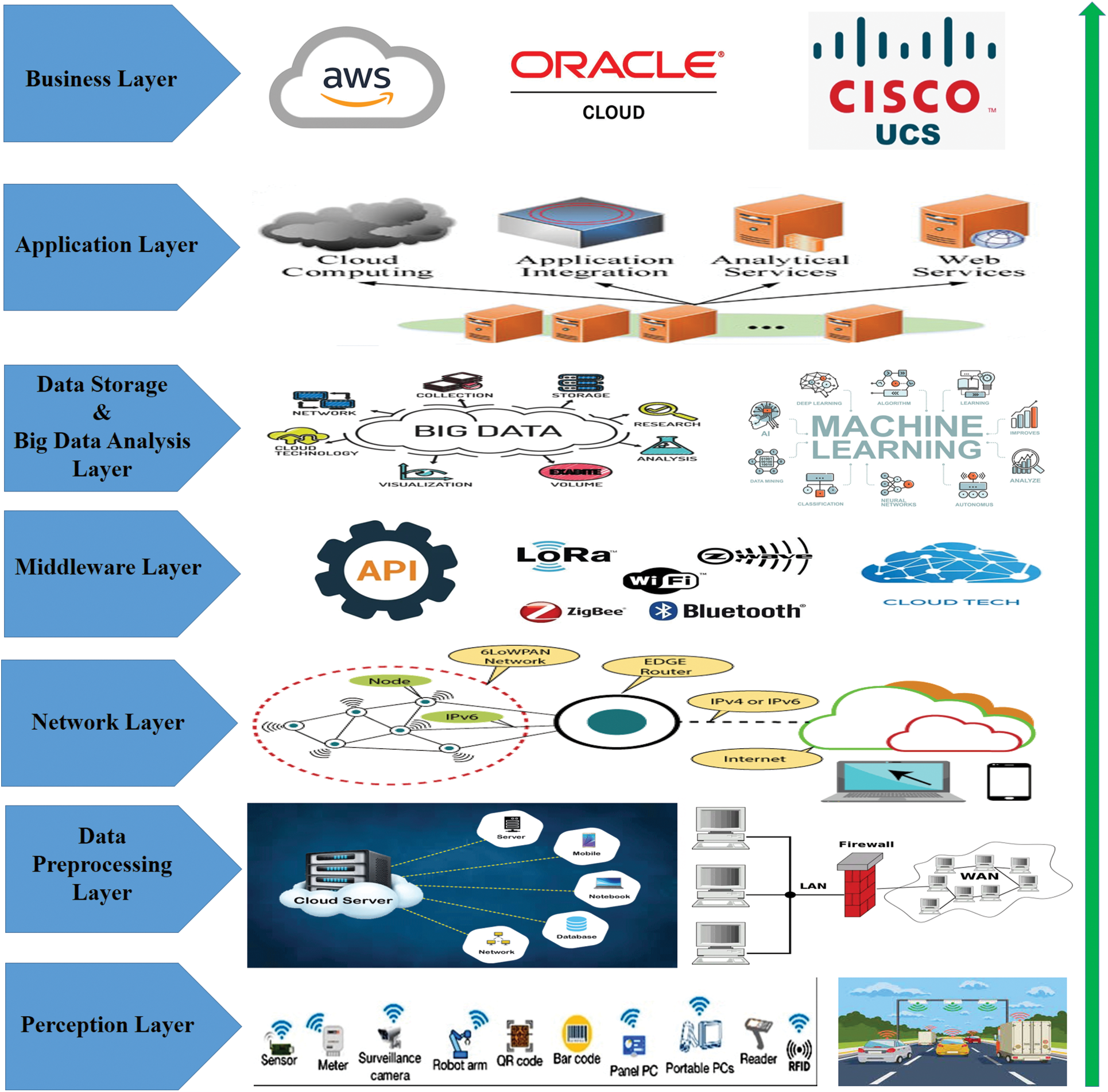
Figure 1: The proposed seven-layered IoT architecture

3 Assessment of Various Attacks in IoT Architecture
In this part, we have suggested a classification system for the various attack types based on how frequently they occur in the IoT framework. The older work [47] has the following shortcomings:
• The number of criteria for an assessment was limited to only four.
• The range for evaluating the attacks does not fit within the level where 1 denotes low, 2 is medium and 3 is high.
To increase the accuracy of determining the likelihood of attacks, we have chosen eight separate criteria, where level 1 denotes low, level 2 is medium, and level 3 is high. In Table 2, the newly introduced criteria are listed and denoted with an asterisk (*), and they are more focused on the security risks in the IOT network. The criteria used to categorize the most vulnerable assaults are based on the likelihood of their occurring which ranges from high to low depending on several circumstances.

All the various types of attacks are evaluated on the basis of the probability of occurrence and a range is created to identify the attack as High (3)/Medium (2)/Low (1) which is depicted in Table 3.

We have set the range from 1–3 to determine the level of occurrence of an attack so it becomes easier to decide even if the number of criteria increases or decreases. When there is a combination of different levels of probability of attack (high/medium/low), it becomes a little confusing, so we set a range to determine at which level of occurrence the value can be. While calculating the level of probability of occurrence of an attack initially the total score (TS) is calculated.
Case I: If 1 ≤ SA ≤ 1.499 then the level of probability of occurrence of an attack is low.
Case II: If 1.5 ≤ SA ≤ 2.499 then the level of probability of occurrence of an attack is medium.
Case III: If 2.5 ≤ SA ≤ 3 then the level of probability of occurrence of an attack is high.
In Table 4, various impact levels of attacks are explained.

Let SI is the Impact Score, 1 ≤ SI ≤ 3.
If the range of TA is 1 ≤ TA ≤ 3, the attack is the least dangerous.
If the range of TA is 3 < TA ≤ 6, the attack is more dangerous.
If the range of TA is 6 < TA ≤ 9, the attack is highly dangerous.
We have assumed that the least dangerous attacks are of lesser range as more and highly dangerous attacks are of more concern.
4 Security Threats in the Seven-Layered IoT Architecture
In the present era, security in IoT networks is a topic of the highest importance. To examine the security threats (attacks) that are likely to occur in the IoT architecture, the attacks occurring in layers 50 through 56 of the IoT network deserve the most attention. The attacks in this section have been listed from the most hazardous to the least dangerous so that attention can focus on solving the significant security problems provided by the IoT architecture. The criteria used to categorize the attacks that cause the most harm are based on the likelihood of occurrence (from high to low) and impact (from high to low) on the security of IoT applications.
Layer-wise classification has been made on these attacks which are as follows.
It also goes by the name of a sensing layer. It performs similar tasks to how human eyes, ears, and noses do. It is accountable for recognizing things and gathering information from them. To collect information there are numerous sorts of sensors attached to items such as RFID, 2-D barcode, and sensors. The applications’ needs are taken into account when selecting the sensors. Several forms of information, including position, changes in the surroundings, motion, vibration, etc., can be gleaned from these sensors. But, attackers keep concentrating on them in an effort to utilize them to swap out the sensor with a different one. As an outcome, the bulk of hazards is associated with sensors, as seen in Table 5. After that, Table 6 contains an analysis of these attacks’ vulnerability based on the likelihood of their occurrence (how easily they can be launched in the IoT network), the attacks that can be launched in response to such an attack, and the effect that such an attack has on the security of IoT applications [50].


4.2 The Data Pre-Processing Layer
The IoT architecture now has a new layer [44] that is dedicated to protecting sensor data with machine learning methods. It evaluates the data it receives from the Perception Layer to determine whether it is secure from hackers and viruses. If so, the assault is discovered before being forwarded to the network layer. It verifies the items’ authenticity [51] before passing them on to the network layer. Pre-processing data, which is done using databases, ML algorithms, and cloud computing approaches, is extremely important to create a secure IoT framework because it protects the network layer from heavy traffic and prevents storage devices from exceeding their capacity constraints. We have used the most recent encryption methods, such as AES and DES, to encrypt and decrypt the information for IoT data authentication. Based on their vulnerability, the attacks that are likely to occur are represented in Table 7, and further analysis of the assaults’ vulnerabilities is presented in Table 8.


Before any data is exchanged inside the IoT ecosystem, all connections are formed in this layer via Bluetooth, the Internet, and routing. The network layer is used to send the data obtained from the Data Pre-processing Layer to the online services, or cloud [52]. Innovative technologies like Edge Computing and Fog Computing have been introduced here for the first time in order to decrease the latency in the transport of IoT data. The key assaults to which this layer is vulnerable are forecast in Table 9, and their vulnerability analysis is shown in Table 10.


The bulk of IoT network security solutions now includes cloud services to support current IoT devices. As a result, the Middleware Layer’s backbone in the proposed architecture uses cloud infrastructure [53]. This layer acts as a bridge between the network and application layers, enabling connectivity between various IoT components. The vulnerability analysis of the assaults is presented in Table 12. Table 11 presents the primary attacks that this layer is vulnerable to in the IoT ecosystem (ranked on their weakness).


4.5 The Data Storage and Big Data Analysis Layer
Big Data management, data storage, and data analysis are all handled by this layer. We suggested IoT architecture incorporates a framework based on data storage for the first time, allowing us to store both non-structured and structured IoT data. The Hadoop framework and a number of other databases are used in the innovative design to manage the data that the sensors and actuators collect in the Perception Layer. Data profiling, data mining, and the application of machine learning are all topics covered by data analysis [54–61]. Before distributing information to customers, it is crucial for businesses to comprehend the issues and conduct relevant analyses of the data (Application layer). Data analysis can be used to predict cyberattacks, hence this layer is included to guarantee the security of IoT applications. Cybersecurity specialists can assess the data they have collected and then react in real-time thanks to big data analysis. In order to prevent cyberattacks, this layer thus casts a wider net. The vulnerability analysis of the attacks is shown in Table 14. Table 13 lists the primary attacks that this layer is susceptible to in the IoT ecosystem (ranked by their vulnerabilities).


There is no layer presented here. Encrypting and decrypting IoT data and converting communication protocols between layers are among this layer’s primary responsibilities. The IoT nodes, firmware, and gateways [61] connect the IoT devices to the application layer. Table 15 shows the security flaws in the gateways, and Table 16 shows how vulnerable they are to assaults.


This is the sixth and most challenging layer in the suggested IoT architecture. The application layer provides services to the applications and supports business values based on the data collected by sensors. Smart homes, smart cities, smart healthcare, animal tracking [62,63], and other topics are discussed in the applications of IoT [64,65]. The launch of botnets, buffer overflows, and reprogramming assaults like those in Table 17 that harm the IoT network are some of the most hazardous attacks that affect the application layer [59] and target the IoT network. Table 18 provides an analysis of these attackers’ vulnerabilities.
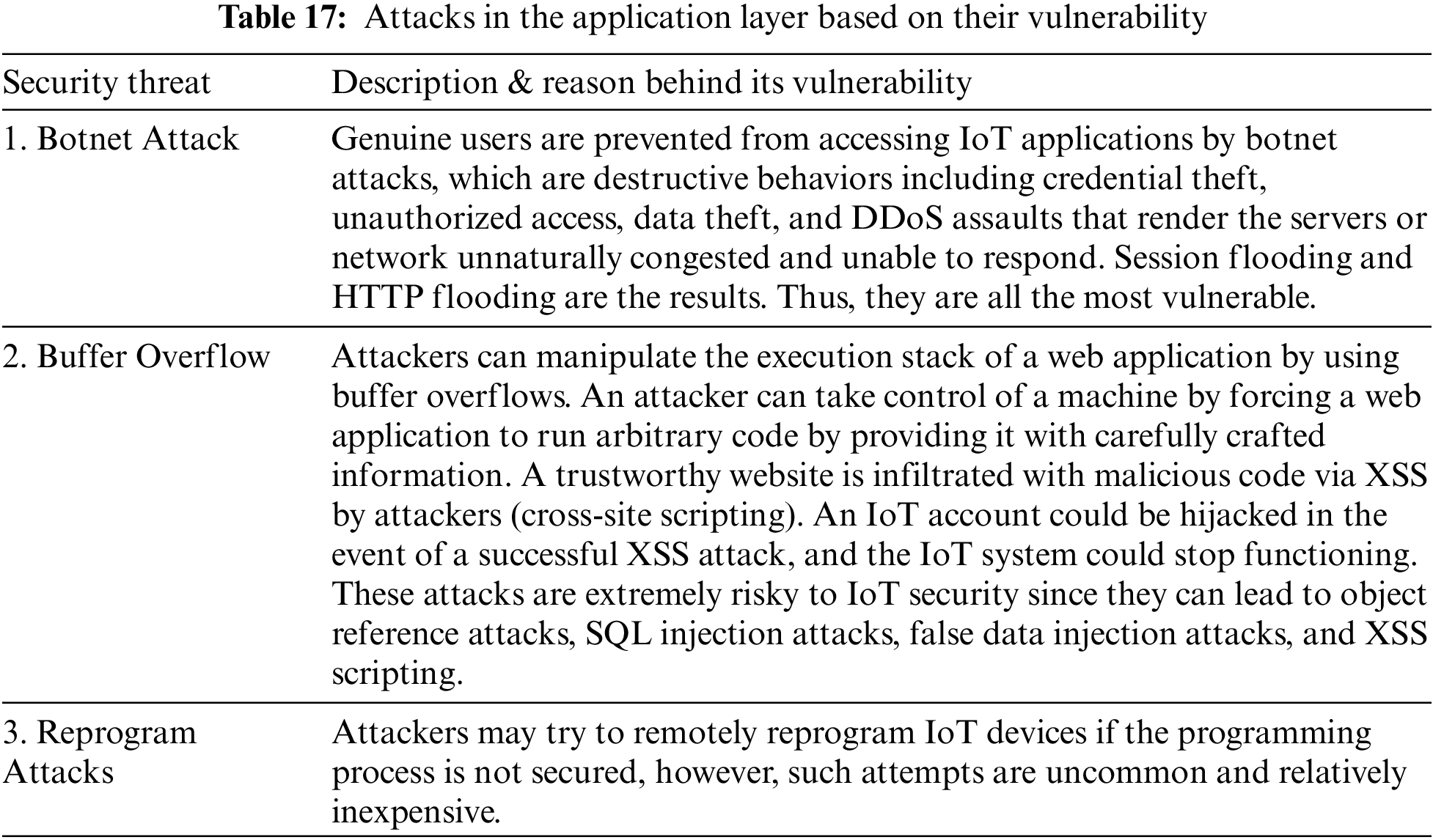

The entire Internet of Things system, including all apps, business and financial models, and user privacy, is managed by this business layer. The cloud-based IoT frameworks create a set of guidelines and regulations for managing data and messaging amongst the many participants in the IoT network, including users, devices, and the cloud system [66]. These frameworks make it possible to deploy high-level IoT applications quickly while hiding the complexity of the underlying protocols. This layer includes platforms like AWS IoT, Bosh IoT, Cisco IoT, Google IoT, and Oracle IoT. The primary attacks are identified in Table 19 and their analysis is provided in Table 20, even though the business layer is not particularly vulnerable to many of them.


5 ML and DL Algorithms in Detecting and Mitigating the Attacks in Seven-Layer Architecture
The identification of external dangers is the first stage in providing security. Without a reliable environment, the tremendous demand for these devices could disappear and their potential could be squandered. The Internet of Things will be the primary source of fresh information used to develop increasingly clever uses for smart sensors. All IoT networks, whether they are presently in use or will be in the future, urgently require security. Smart sensors are being used more and more frequently in our daily lives. Security issues are therefore in demand right now.
Because of their exceptional ability to anticipate assaults and mitigate them, machine learning and deep learning [67] techniques been widely employed in a number of real-world applications [68–76]. The current machine learning methods are low-cost and computationally cheap, and they support the growth of Big Data. However, not all algorithms can effectively identify all types of attacks, and only a select few algorithms are most effective for identifying and thwarting different attacks in the IoT architecture [77].
Several well-known Machine Learning [78] and Deep Learning algorithms, including SVM, Decision Trees and Random forests, Nave Bayes, Artificial Neural networks, and Deep Q learning algorithms, have been used in this section of the paper to detect attacks that have occurred at various layers of the IoT architecture. Because certain attacks target many layers, as we have shown, it is crucial to anticipate them in order to create a more secure IoT framework. According to our knowledge, we are the first to have worked with these conventional and a few untested algorithms that, on their own, are capable of foreseeing many of these significant threats and can be used to secure many layers at once. This ML and DL solutions are shown in Table 21 and are intended to forecast a variety of assaults that could harm more than one layer of the suggested design.
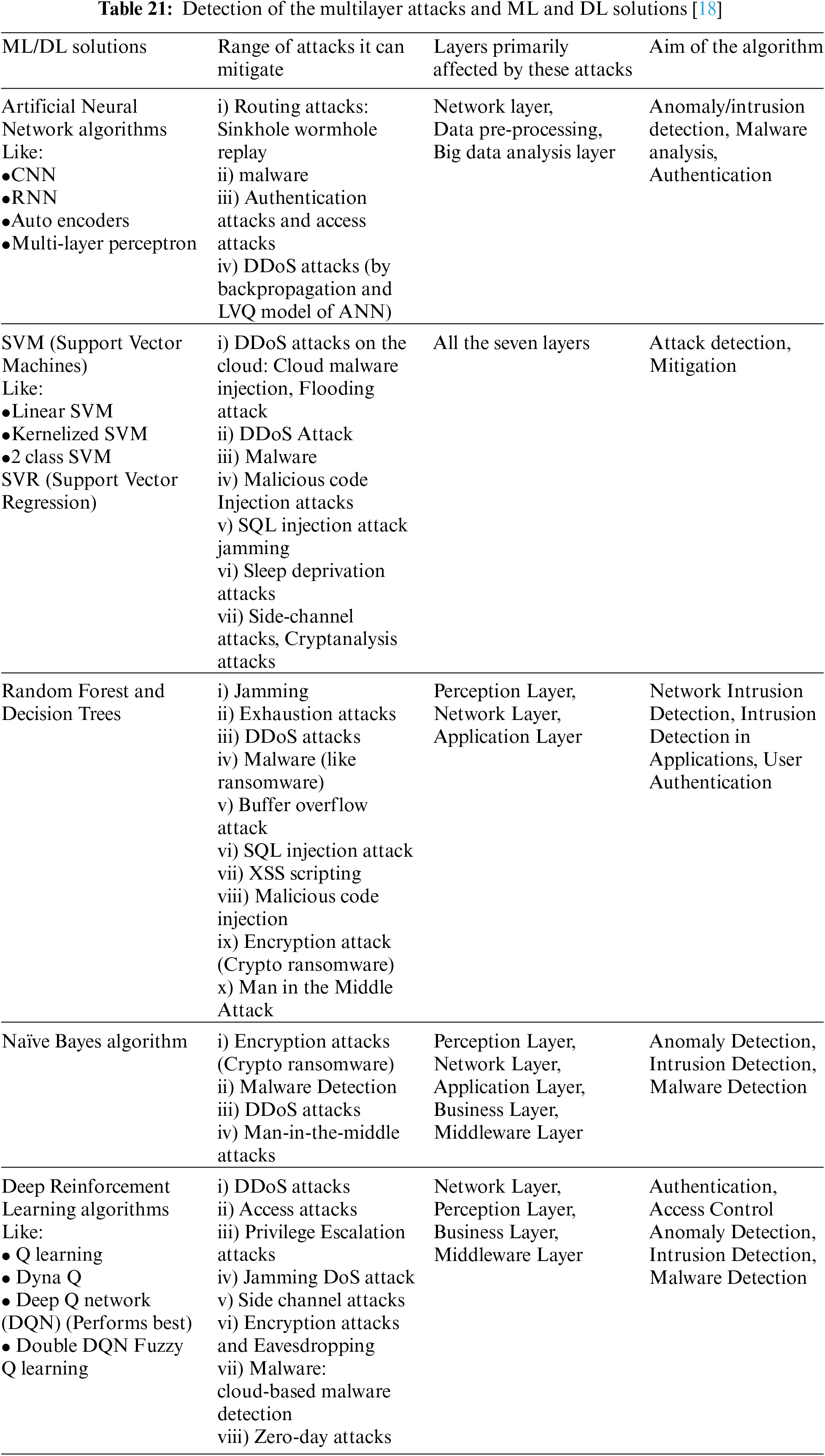
It has been found that artificial neural networks algorithms like RNN (Recurrent neural networks), Auto encoders, CNN (convolutional neural networks), and Multilayer perceptron can be used to accurately detect DDoS attacks, malware, authentication attacks, access attacks, and routing attacks, which primarily target the Network Layer, data pre-processing, and Big Data analysis layers. To ensure a more secure IoT platform, artificial neural network algorithms seek to carry out intrusion detection, malware analysis, and authentication.
Linear SVM, Kernelized SVM, and Support Vector Regressors are examples of Support Vector Machines that may identify DDoS assaults that target the middleware layer of the cloud as well as other DDoS attacks that target all other levels of the IoT architecture. Together with a variety of cryptanalysis and jammer assaults aimed at the perception layer, it may also foresee the presence of malware in the Data Preprocessing and Big Data analysis layer.
Random forests and decision trees, on the other hand, are incredibly flexible because they can reliably identify attacks like jamming, exhaustion, DDoS, malware (like ransomware), buffer overflows leading to object referencing attacks, SQL injection attacks, XSS scripting, malicious code injection, encryption attacks (like Crypto ransom wares), and Man in the Middle Attacks. The Perception layer, Network layer, and Application layers—all of which are vulnerable to significant attacks—are the most crucial levels that make up the IoT architecture. Algorithms for Random Forests and Decision Trees can be employed exclusively to serve a variety of security-related functions in IoT applications, including intrusion detection [79] in smart networks and smart apps as well as to verify the authenticity of IoT devices.
In order to create Machine Learning models that are capable of making speedy predictions, we have also worked with the Naive Bayes method, one of the most straightforward and efficient categorization techniques. It is a probabilistic classifier that performs exceptionally well at identifying malware, TCP, UDP, and HTTP flooding DoS assaults, Man in Middle attacks, and attacks on the application, business, middleware, and network layers.
The area of Deep Reinforcement learning algorithms has not before been extensively examined, as it is in this study. They may offer a way to detect the security threats that are present throughout the IoT infrastructure, as we have shown. It is possible to accurately predict the presence of DDoS attacks, access attacks, privilege escalation attacks, jamming attacks, snooping attacks that may launch MITM and Relay attacks, encryption attacks, and malware with the help of algorithms like Q learning, Dyna Q, Deep Q Network (DQN), Double DQN, and Fuzzy Q learning. If these attacks are effectively identified, the network layer, middleware layer, and perception layer can all be made secure. On the other hand, a range of heterogeneous Internet of Things (IoT) protocols have led to an exponential rise in the number of zero-day attacks and business logic attacks. Several centralized-based strategies have been presented [78–80] to detect harmful activity in IoT systems. To meet IoT needs, many techniques have suffered from a high delay. These business layer assaults are also detectable by Deep Q Network techniques.
6 Performance Analysis of ML and DL Algorithms for Detecting and Mitigating the IoT Attacks for Seven Layer Architecture
The numerous Machine Learning [80–88] and Deep Learning Algorithms that can be developed in order to detect and mitigate attacks in the seven-layer architecture of IoT [54–61,67] have been mentioned in the preceding section. This section’s thorough analysis of these algorithms aims to considerably comprehend the computation and cost (time and space complexities) of these methods. Although Deep Learning is a subsection of Machine Learning the prediction accuracy and the self-learning properties of these algorithms are particularly useful to stay up with the current breakthroughs in IoT. The algorithms suggested here are thoroughly analyzed in Tables 22 to 29 to provide a comprehensive understanding of the jobs they accomplish, their time and space complexity, the training time needed, the computational difficulties [89,90], advantages, and disadvantages as well as classification accuracy.
Understanding which machine learning or deep learning algorithm is best for a certain attack requires knowledge of the aforementioned algorithms (Table 30 and Fig. 2 present the classification accuracy of the IoT attacks for seven-layered architecture). The few characteristics that make up an algorithm’s work, cost relative to time, cost relative to space, training time, and computational complexity serve as the foundation for analysis.

Figure 2: The graphical representation of the DL and ML models’ performance on IoT attacks
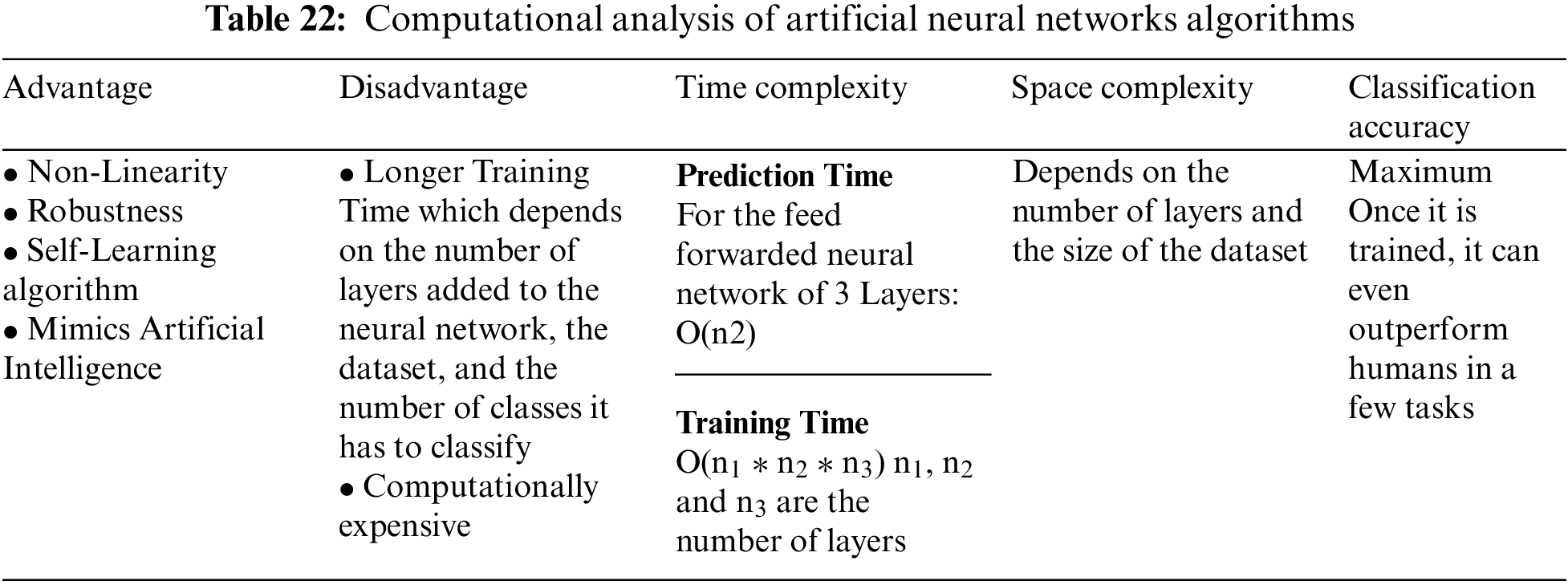
6.2 Support Vector Machines and Support Vector Regressors
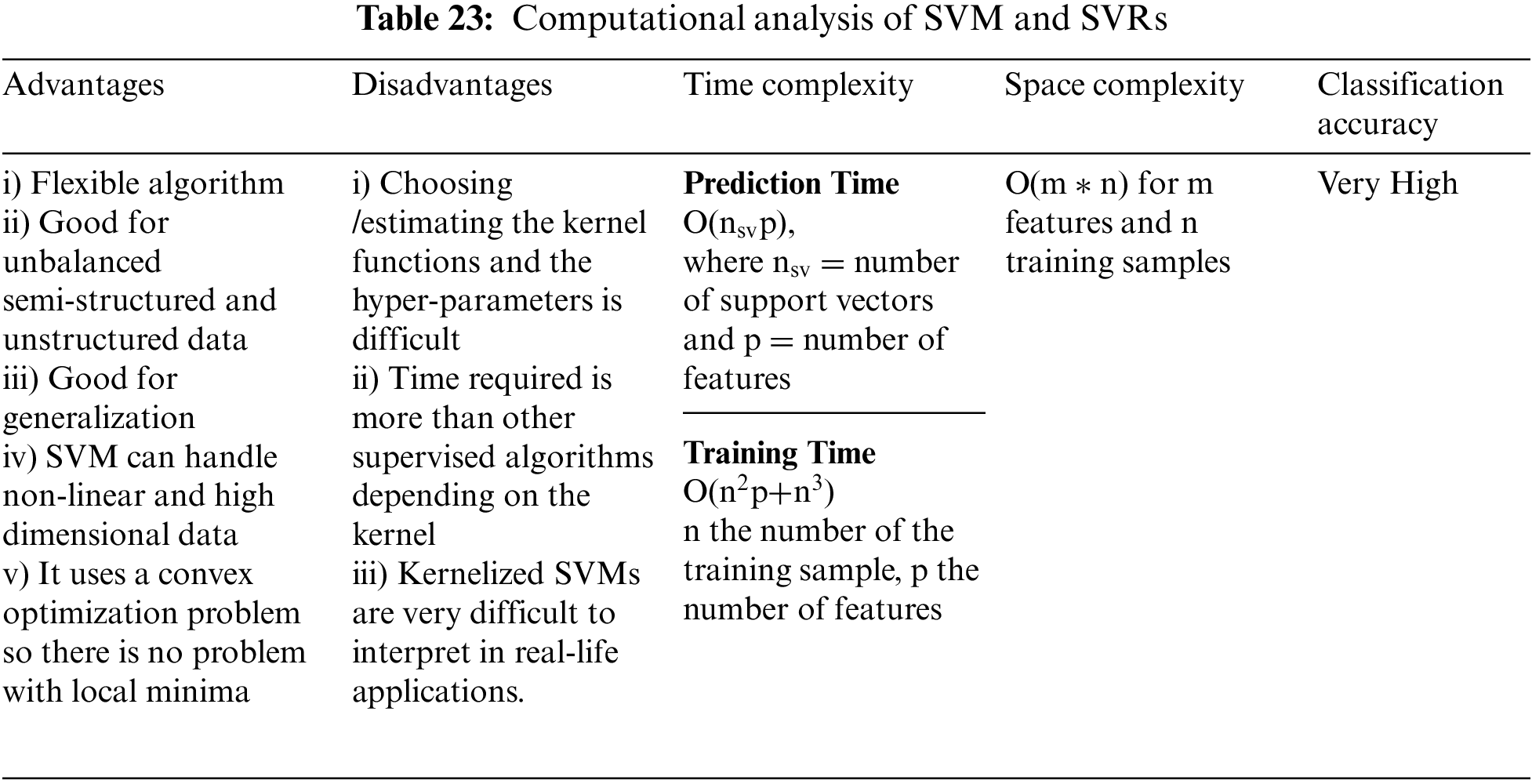
6.3 Random Forest and Decision Trees
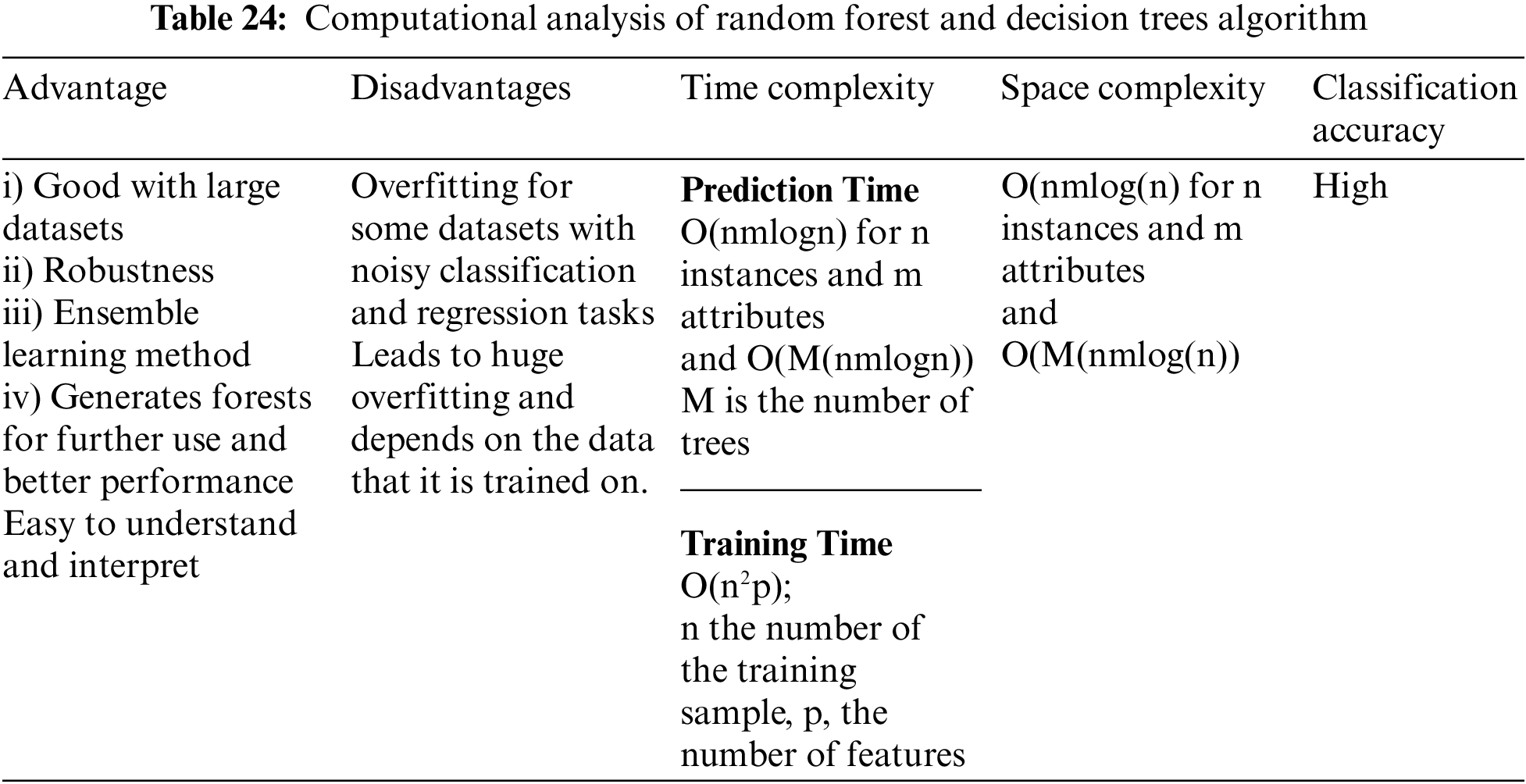
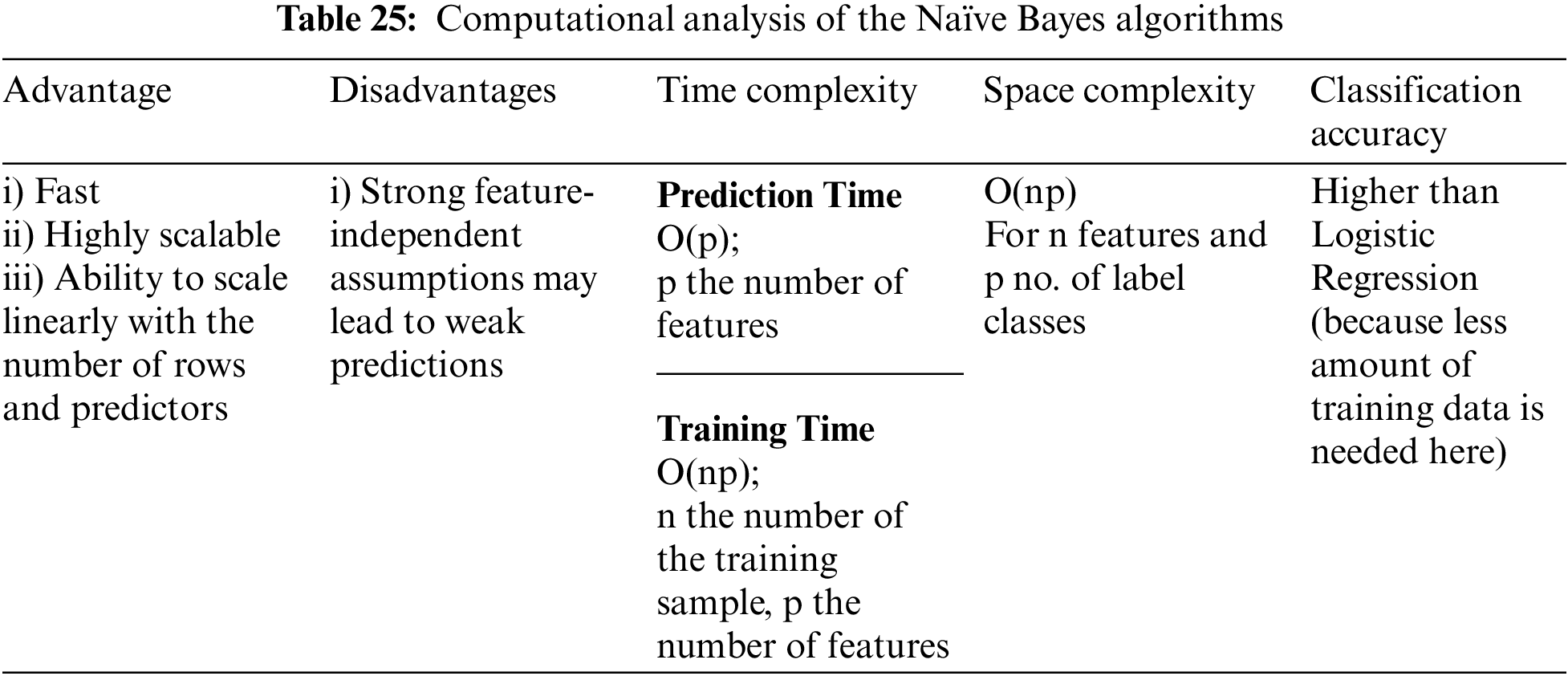
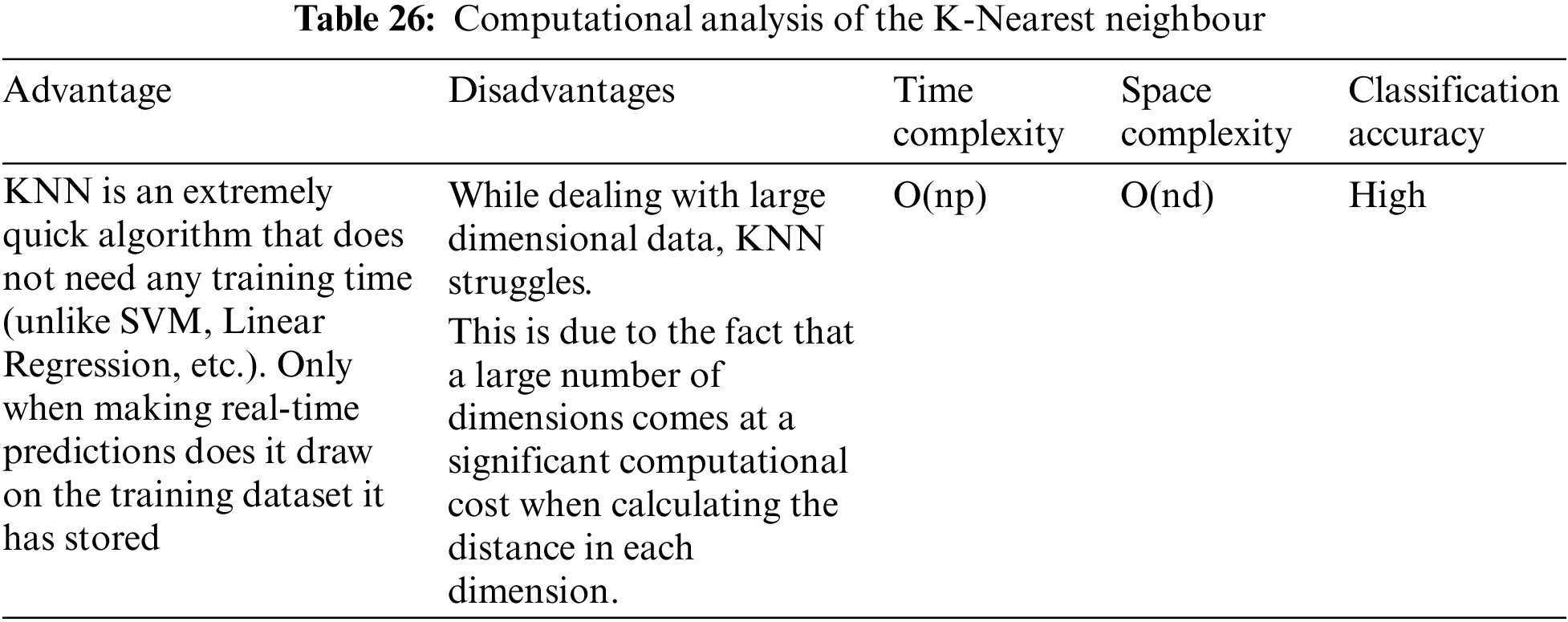

6.7 Principal Component Analysis (PCA)
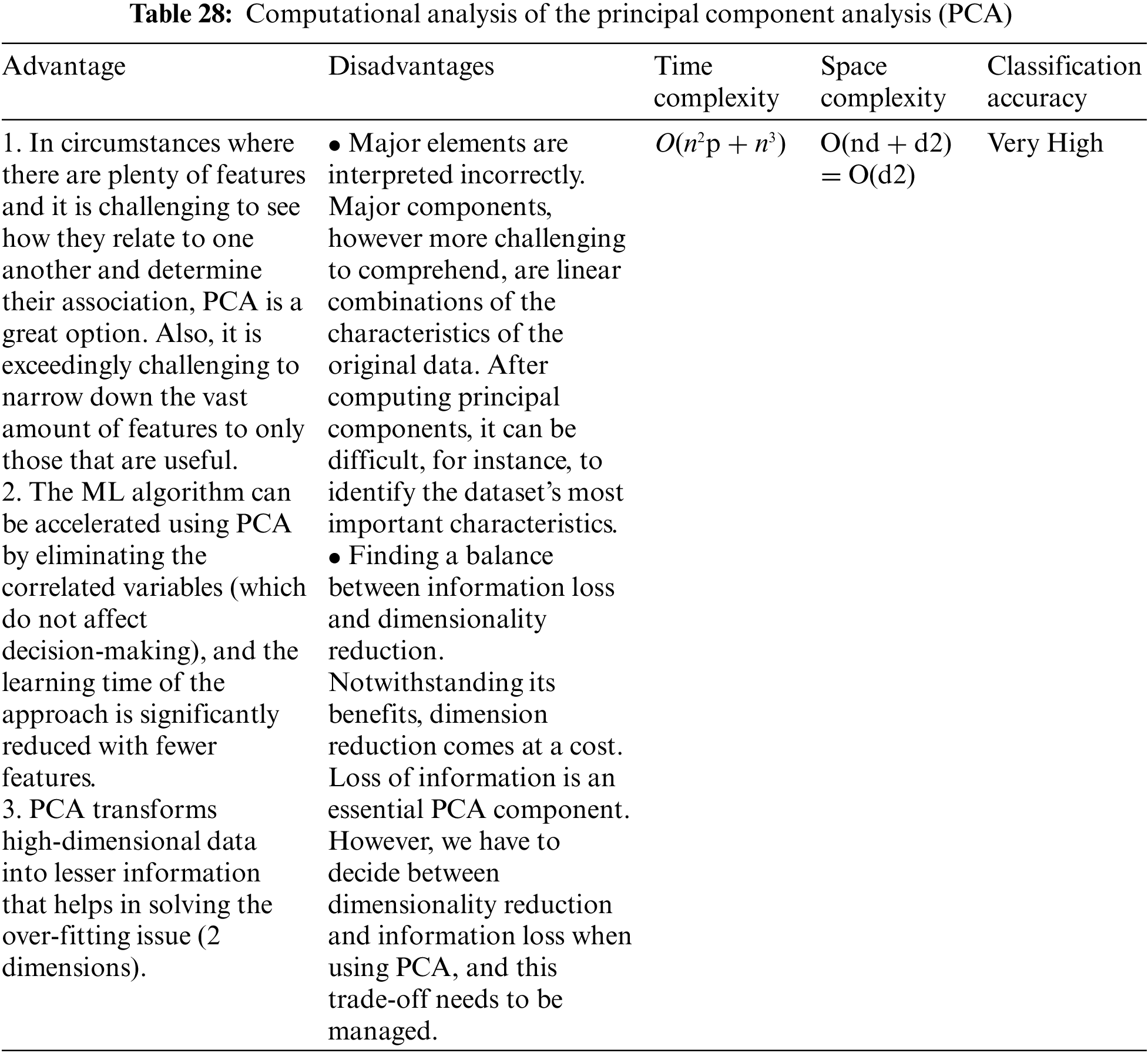
6.8 Deep Reinforcement Learning Algorithms

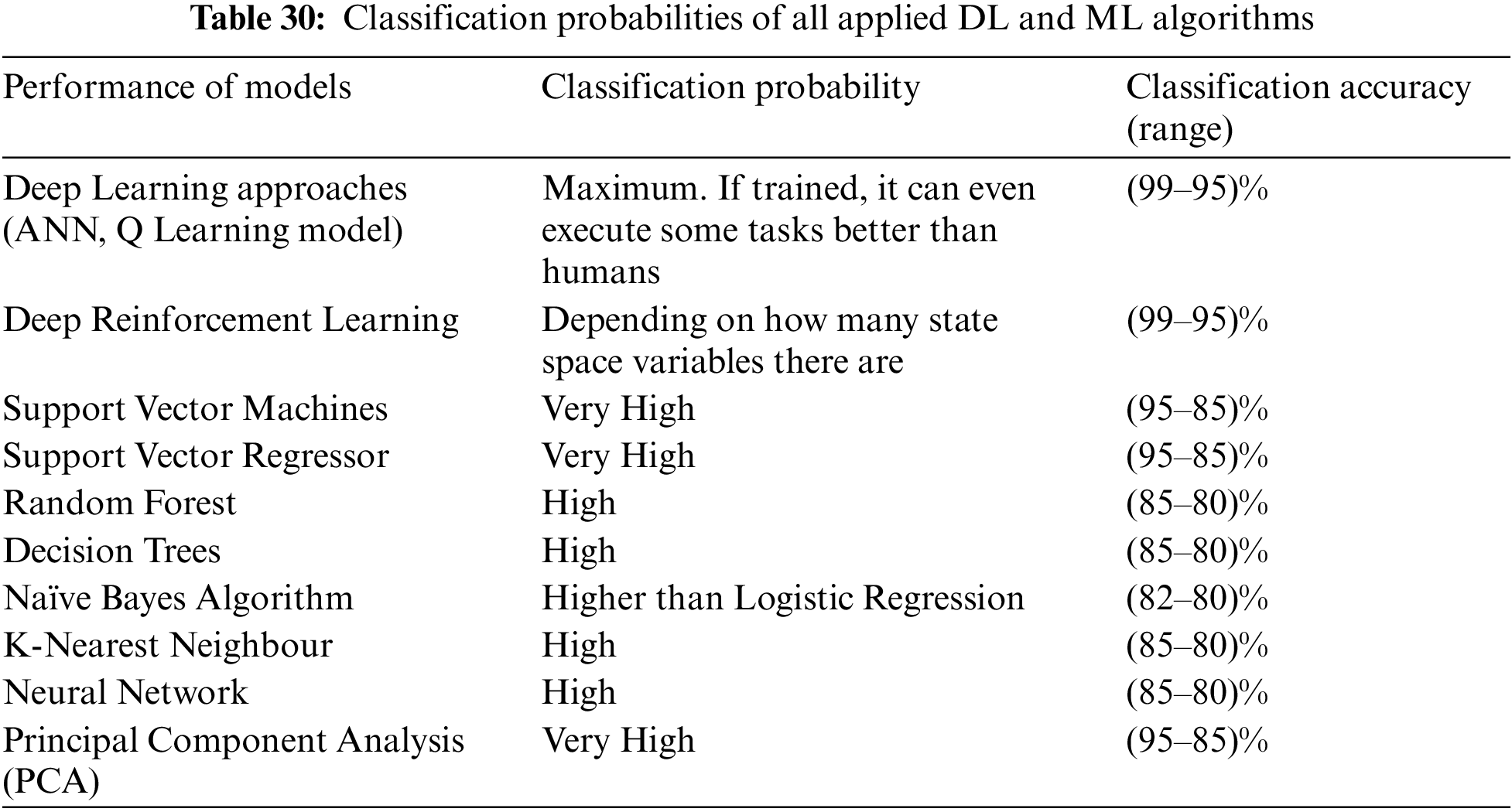
The IoT environment faces a variety of difficulties that, with more work, can be successfully handled. It is essential to understand the industry and its requirements, risks, prices, and privacy concerns in order to deliver an end-to-end secure IoT platform for human consumption. In this section of the report, the significant difficulties as well as potential future research directions are discussed. These are what they are:
Data analysis using ML and AI algorithms while safeguarding the fog layer.
A variety of ML and AI approaches can be applied to increase the intelligence of the fog layer. The fog layer must be able to decide how long the data should be kept there too and when it should be erased or transferred to the cloud for extended storage. The efficient implementation of IoT systems depends on data analysis occurring nearby the IoT node and in real-time. Instead of having to send the data elsewhere for analysis, a number of ML and DL-based algorithms can be developed to analyze the data in the node itself. By limiting data flow, the security of the application can be further improved.
7.1 Design of a Service-Oriented Language (SOL)
Secure data transfer, data processing, and management of the entire Internet of Things ecosystem are now burdensome due to the cost of maintaining a high level of user service in this period of quick technological breakthroughs. The Internet of Things is a platform for diverse networks that makes it more difficult for different devices and communication technologies to function together, which makes the network more susceptible to hacking and slowdowns. A widely accepted language that is service-oriented should be created taking into account network services for the industry’s benefit. With the aid of such a language, the creation of services, their implementation, and the integration of resources will be simpler, minimizing overall market losses and ensuring service-oriented secure communication.
7.2 A Consolidated Information Framework (CIF) Needs to be Created
There are currently an enormous number of IoT-connected gadgets that are collecting real-time data. This data require the control of a high-frequency, high-bandwidth route. A CIF must be developed to fulfill the requirements of Big Data. The database management systems that are currently in use are unable to handle the amounts of real-time data obtained by all of these IoT devices. In order to solve the existing issue, additional work might be done to increase the effectiveness of large data storage. By analyzing various threat detections and mitigations utilizing ML and DL techniques.
7.3 Data Mining and Secure Routing Protocols Should Be Obtained
The real-time sensors and actuators do not filter the raw data they collect. It takes effective decision-making and data mining to sort through the vast amounts of recorded data. Here, a big data strategy should be used. In order to support the present IoT ecosystem, secure routing protocols need also be developed that can manipulate the web services that may be implemented in addition to the inclusion of cutting-edge software.
7.4 Efficient Block Chain Mining Algorithms for IoT Security
The Block Chain is a scalable, decentralized platform that can securely record confirmed transactions. Blockchain has been used by several researchers to secure IoT applications. But, the existing blockchain mining algorithms incur a substantial computational overhead which in turn makes the entire system costlier and raises the average energy depletion and computational interruption. End-to-end encryption must therefore be incorporated into the design of effective blockchain mining algorithms in order to guarantee a quick, low-cost, low-energy manner of securely storing transactions.
7.5 Security, Communication, and Identification Normalization in IoT
A significant barrier to making IoT services safer is the interoperability problem. Another approach that needs to be used to develop a safe IoT ecosystem is normalization or standardization. In order for diverse IoT applications to compete more effectively with the created apps in the Application Layer of IoT design, it is necessary to lower initial barriers for service providers. As IoT technologies proliferate, security, connectivity, and identity standards must be standardized in a way that enables an effective deployment of IoT applications.
7.6 Implementation of Fog Computing in Designing a Strong Security Mechanism for IoT
Although ML, DL, and RL have been used in this study to present the existing solutions for the network security of IoT applications, additional work is still required to guarantee an end-to-end protected IoT network. In this regard, deploying fog computing can assist in lowering network traffic and latency. Using fog computing, a robust security system must be created so that assaults may be stopped before they reach the cloud. The IoT application will be more dependable and secure as a result of the decreased network traffic and attacks.
7.7 Developing Simple Cryptographic Protocols Shield Internet of Things Devices from Potential Threats
IoT devices are limited by their battery life. It is possible to create a small cryptographic protocol for secure and energy-efficient communication.
7.8 Powerful Battery Backed Up Smart Edge Devices for IoT Security
Edge computing has been applied in a number of industries, such as sustainable farming, green cities, and smart healthcare. However, under the IoT design, edge devices are very vulnerable to attacks. If the edge layer is not secure, the entire IoT ecosystem is going to be in danger. They mostly rely on battery backups because they are resource-limited. The entire Internet of Things (IoT) ecosystem becomes vulnerable to attacks if the edge device’s battery is somehow drained, such as by forcing it to run in an endless loop by a hacker. So, in order to avoid battery drain and guarantee the safety of the overall IoT ecosystem, it is essential to create smart edge devices with a substantial battery backup.
7.9 Developing an Application-Specific Data Protection Technique Is Very Necessary
The healthcare system will need appropriate access control systems to secure sensitive health records while maintaining data integrity and confidentiality is of the utmost importance in the case of VANET.
7.10 Developing Protective Measures against Traffic Analysis Attacks
Preventing traffic analysis, which keeps data communication in IoT networks private, is another key research field. However, it is accepted that more research may be done in this area to offer a more reliable and safe framework for IoT programs to work in, even if potential solutions for IoT security have been revealed. To revolutionize the way people perceive IoT technology and to make it accessible to students around the world, future work can be pursued to make the IoT system more capable of being implemented in the academic field. This will enhance a brighter future for readers in particular and the globe in general.
IoT security has become more complex day by day. Additionally, it is crucial to safeguard the entire IOT environment due to technological improvements and new threats to the IoT ecosystem that have been noticed. Advanced Machine Learning, Deep Learning, and Reinforcement learning have enhanced IOT security. In this paper, the multilayer security threats occurred based on their vulnerabilities to the service-oriented IoT network, and their applications are solved by a novel and modern technological architecture to increase the security of the IoT ecosystem. Evaluation parameters like the ease of launching the attack, the probability of occurrence of the attacks, etc., have been analyzed by the ML and DL techniques to predict a range of attacks so that to mitigate several attacks at a time.
The feasibility of the algorithms presented in this paper is explored to make it more transparent which algorithm should be used and why. Each method has been compared in subsections of the paper to demonstrate their aim, advantages, disadvantages, and real-world application areas. In order to improve IoT security, the time and spatial complexity of each of these methods has been presented along with their computing costs and prediction accuracy. This paper aims to encourage research enthusiasts to make advancements in the IoT ecosystem for secure, reliable, and available networks and pave their way to design a more intelligent end-to-end secured IoT ecosystem.
Acknowledgement: All the above authors prepared this manuscript themselves.
Funding Statement: The authors received no specific funding for this study.
Author Contributions: All the authors have equal contribution to prepare the manuscript.
Availability of Data and Materials: We have not used any type dataset or materials from the external source.
Conflicts of Interest: The authors declare that they have no conflicts of interest to report regarding the present study.
References
1. H. N. Saha, A. Mandal and A. Sinha, “Recent trends in the Internet of Things,” in IEEE 7th Annual Computing and Communication Workshop and Conf. (CCWC), Las Vegas, NV, pp. 1–4, 2017. [Google Scholar]
2. H. N. Saha, N. Saha, R. Ghosh and S. Roychoudhury, “Recent trends in implementation of Internet of Things–A review,” in IEEE 7th Annual Information Technology, Electronics and Mobile Communication Conf. (IEMCON), Vancouver, BC, pp. 1–6, 2016. [Google Scholar]
3. J. Muangprathub, N. Boonnam, S. Kajornkasirat, N. Lekbangpong, A. Wanichsombat et al., “IoT and agriculture data analysis for smart farm,” Computers and Electronics in Agriculture, vol. 156, pp. 467–474, 2019. [Google Scholar]
4. G. Lavanya, C. Rani and P. Ganeshkumar, “An automated low cost IoT based fertilizer intimation system for smart agriculture,” Sustainable Computing: Informatics and Systems, vol. 28, pp. 100300, 2020. [Google Scholar]
5. F. Bu and X. Wang, “A smart agriculture IoT system based on deep reinforcement learning,” Future Generation Computer Systems, vol. 99, pp. 500–507, 2019. [Google Scholar]
6. K. Lakhwani, H. Gianey, N. Agarwal, S. Gupta, V. Rathore et al., “Development of IoT for smart agriculture a review,” in Emerging Trends in Expert Applications and Security. Singapore: Springer, pp. 425–432, 2019. [Google Scholar]
7. B. R. Stojkoska and K. V. Trivodaliev, “A review of Internet of Things for smart home: Challenges and solutions,” Journal of Cleaner Production, vol. 140, no. 3, pp. 1454–1464, 2017. [Google Scholar]
8. T. K. L. Hui, R. S. Sherratt and D. Díaz Sánchez, “Major requirements for building smart homes in smart cities based on Internet of Things technologies,” Future Generation Computer Systems, vol. 76, pp. 358–369, 2017. [Google Scholar]
9. M. Alaa, A. A. Zaidan, B. B. Zaidan, M. Talal and M. L. M. Kiah, “A review of smart home applications based on Internet of Things,” Journal of Network and Computer Applications, vol. 97, pp. 48–65, 2017. [Google Scholar]
10. S. R. Paveethra, B. Barathi, M. Geethapriya, M. Arthi and V. Ahasthiya, “Theoretical modelling and implementation of home energy management system using IoT based automation system,” Materials Today: Proceedings, vol. 45, pp. 1790–1793, 2020. [Google Scholar]
11. T. Kim, C. Ramos and S. Mohammed, “Smart city and IoT,” Future Generation Computer Systems, vol. 76, pp. 159–162, 2017. [Google Scholar]
12. Y. Qian, D. Wu, W. Bao and P. Lorenz, “The Internet of Things for smart cities: Technologies and applications,” IEEE Network, vol. 33, no. 2, pp. 4–5, 2019. [Google Scholar]
13. V. A. Memos, K. E. Psannis, Y. Ishibashi, B. Kim and B. B. Gupta, “An efficient algorithm for media-based surveillance system (EAMSuS) in IoT smart city framework,” Future Generation Computer Systems, vol. 83, pp. 619–628, 2018. [Google Scholar]
14. H. N. Saha, S. Gon, A. Nayak and S. Moitra, “IoT based garbage monitoring and clearance alert system,” in 2018 IEEE 9th Annual Information Technology, Electronics and Mobile Communication Conf. (IEMCON), Vancouver, Canada, pp. 204–208, 2018. [Google Scholar]
15. L. Greco, G. Percannella, P. Ritrovato, F. Tortorella and M. Vento, “Trends in IoT based solutions for health care: Moving AI to the edge,” Pattern Recognition Letters, vol. 135, pp. 346–353, 2020. [Google Scholar] [PubMed]
16. S. Selvaraj and S. Sundaravaradhan, “Challenges and opportunities in IoT healthcare systems: A systematic review,” SN Applied Sciences, vol. 2, pp. 641, 2020. https://doi.org/10.1007/s42452-019-1925-y [Google Scholar] [CrossRef]
17. H. A. El Zouka and M. Hosni, “Secure IoT communications for smart healthcare monitoring system,” Internet of Things, vol. 13, pp. 100036, 2019. [Google Scholar]
18. M. Tavana, V. Hajipour and S. Oveisi, “IoT-based enterprise resource planning: Challenges, open issues, applications, architecture, and future research directions,” Internet of Things, vol. 11, pp. 100262, 2020. [Google Scholar]
19. H. N. Saha, S. Gon, A. Nayak, S. kundu and S. Moitra, “IoT based garbage monitoring and clearance alert system,” in IEEE 9th Annual Information Technology, Electronics and Mobile Communication Conf. (IEMCON), Vancouver, BC, Canada, pp. 204–208, 2018. [Google Scholar]
20. Y. Jung and R. Agulto, “A public platform for virtual IoT-based monitoring and tracking of COVID-19,” MDPI Electronics, vol. 10, no. 1, pp. 12, 2021. [Google Scholar]
21. A. Mosenia and N. K. Jha, “A comprehensive study of security of Internet-of-Things,” IEEE Transactions on Emerging Topics in Computing, vol. 5, no. 4, pp. 586–602, 2017. [Google Scholar]
22. Y. Yang, L. Wu, G. Yin, L. Li and H. Zhao, “A survey on security and privacy issues in Internet-of-Things,” IEEE Internet of Things Journal, vol. 4, no. 5, pp. 1250–1258, 2017. [Google Scholar]
23. M. Frustaci, P. Pace, G. Aloi and G. Fortino, “Evaluating critical security issues of the IoT world: Present and future challenges,” IEEE Internet of Things Journal, vol. 5, no. 4, pp. 2483–2495, 2017. [Google Scholar]
24. F. A. Alaba, M. Othman, I. A. T. Hashem and F. Alotaibi, “Internet of Things security: A survey,” Journal of Network and Computer Applications, vol. 88, pp. 10–28, 2017. [Google Scholar]
25. A. R. Sfar, E. Natalizio, Y. Challal and Z. Chtourou, “A roadmap for security challenges in the Internet of Things,” Digital Communications and Networks, vol. 4, no. 2, pp. 118–137, 2018. [Google Scholar]
26. M. Noor and H. Hassan, “Current research on Internet of Things (IoT) security: A survey,” Computer Networks, vol. 148, pp. 283–294, 2019. [Google Scholar]
27. B. Liao, Y. Ali, S. Nazir, L. He and H. U. Khan, “Security analysis of IoT devices by using mobile computing: A systematic literature review,” IEEE Access, vol. 8, pp. 120331–120350, 2020. [Google Scholar]
28. M. M. Ogonji, G. Okeyo and J. M. Wafula, “A survey on privacy and security of Internet of Things,” Computer Science Review, vol. 38, pp. 100312, 2020. [Google Scholar]
29. F. Meneghello, M. Calore, D. Zucchetto, M. Polese and A. Zanella, “IoT: Internet of threats? A survey of practical security vulnerabilities in real IoT devices,” IEEE Internet of Things Journal, vol. 6, no. 5, pp. 8182–8201, 2019. [Google Scholar]
30. M. Ammar, G. Russello and B. Crispo, “Internet of Things: A survey on the security of IoT frameworks,” Journal of Information Security and Applications, vol. 38, pp. 8–27, 2018. [Google Scholar]
31. V. Hassija, V. Chamola, V. Saxena, D. Jain, P. Goyal et al., “A survey on IoT security: Application areas, security threats, and solution architectures,” IEEE Access, vol. 7, pp. 82721– 82743, 2019. [Google Scholar]
32. L. Antão, R. Pinto, J. Reis and G. Gonçalves, “Requirements for testing and validating the industrial Internet of Things,” in IEEE Int. Conf. on Software Testing, Verification and Validation Workshops (ICSTW), Vasteras, pp. 110–115, 2018. [Google Scholar]
33. X. Luo, L. Yin, C. Li, C. Wang, F. Fang et al., “A lightweight privacy-preserving communication protocol for heterogeneous IoT environment,” IEEE Access, vol. 8, pp. 67192–67204, 2020. [Google Scholar]
34. H. Mrabet, S. Belguith, A. Alhomoud and A. Jemai, “A survey of IoT security based on a layered architecture of sensing and data analysis,” Sensors Journal, vol. 20, no. 13, pp. 3625, 2020. [Google Scholar]
35. M. A. M. Sadeeq, S. R. M. Zeebaree, R. Qashi, S. H. Ahmed and K. Jacksi, “Internet of Things security: A survey,” in 2018 Int. Conf. on Advanced Science and Engineering (ICOASE), Duhok, Iraq, pp. 162–166, 2018. [Google Scholar]
36. S. Tweneboah-Koduah, K. E. Skouby and R. Tadayoni, “Cyber security threats to IoT applications and service domains,” Wireless Personal Communication, vol. 95, pp. 169–185, 2017. [Google Scholar]
37. K. Chen, S. Zhang, Z. Li, Y. Zhang, Q. Deng et al., “Internet-of-Things security and vulnerabilities: Taxonomy, challenges, and practice,” Journal of Hardware System Security, vol. 2, pp. 97–110, 2018. [Google Scholar]
38. Q. Gou, L. Yan, Y. Liu and Y. Li, “Construction and strategies in IoT security system,” in 2013 IEEE Int. Conf. on Green Computing and Communications and IEEE Internet of Things and IEEE Cyber, Physical and Social Computing, Beijing, China, pp. 1129–1132, 2013. [Google Scholar]
39. P. Hao, X. Wang and W. Shen, “A collaborative PHY-aided technique for end-to-end IoT device authentication,” IEEE Access, vol. 6, pp. 42279–42293, 2018. [Google Scholar]
40. D. Chasaki and C. Mansour, “Security challenges in the Internet of Things,” International Journal of Space-Based and Situated Computing, vol. 5, no. 3, pp. 141–149, 2015. [Google Scholar]
41. M. P. Nath, S. B. B. Priyadarshini, D. Mishra and S. Borah, “A comprehensive study of contemporary IoT technologies and varied machine learning (ML) schemes,” in Soft Computing Techniques and Applications, Advances in Intelligent Systems and Computing, vol. 1248. Singapore: Springer, pp. 623–634, 2021. [Google Scholar]
42. A. Shah and M. Engineer, “A survey of lightweight cryptographic algorithms for IoT-based applications,” in Smart Innovations in Communication and Computational Sciences, vol. 851. Singapore: Springer, pp. 283–293, 2019. [Google Scholar]
43. F. Alshohoumi, M. Sarrab, A. AlHamadani and D. Al-Abri, “Systematic review of existing IoT architectures security and privacy issues and concerns,” International Journal of Advanced Computer Science and Applications, 2019. https://doi.org/10.14569/ijacsa.2019.0100733 [Google Scholar] [CrossRef]
44. P. Sethi and S. R. Sarangi, “Internet of Things: Architectures, protocols, and applications,” Journal of Electrical and Computer Engineering, vol. 2017, pp. 25, 2017. [Google Scholar]
45. M. Burhan, R. A. Rehman, B. Khan and B. S. Kim, “IoT elements, layered architectures and security issues: A comprehensive survey,” Sensors, vol. 18, no. 9, pp. 2796, 2018. https://doi.org/10.3390/s18092796 [Google Scholar] [PubMed] [CrossRef]
46. I. U. Din, M. Guizani, S. Hassan, B. S. Kim, M. K. Khan et al., “The Internet of Things: A review of enabled technologies and future challenges,” IEEE Access, vol. 7, pp. 7606–7640, 2018. [Google Scholar]
47. M. Aydos, Y. Vural and A. Tekerek, “Assessing risks and threats with layered approach to Internet of Things security,” Measurement and Control Journal, vol. 52, no. 5–6, pp. 338–353, 2019. [Google Scholar]
48. K. Xing, S. S. Srinivasan, M. J. Rivera, J. Li and X. Cheng, “Attacks and countermeasures in sensor networks: A survey,” in Business Media. New York, NY: Springer Science, Springer, pp. 25, 2010. [Google Scholar]
49. H. Khattak, M. Ali Shah, S. Khan, I. Ali and M. Imran, “Perception layer security in Internet of Things,” Future Generation Computer Systems, vol. 100, pp. 144–164, 2019. [Google Scholar]
50. S. Rathore and J. Park, “Semi-supervised learning based distributed attack detection framework for IoT,” Applied Soft Computing, vol. 72, pp. 79–89, 2018. [Google Scholar]
51. R. Sharma, N. Pandey and S. K. Khatri, “Analysis of IoT security at network layer,” in 6th Int. Conf. on Reliability, Infocom Technologies and Optimization (Trends and Future Directions) (ICRITO), Noida, pp. 585–590, 2017. [Google Scholar]
52. M. A. A. Da Cruz, J. J. P. C. Rodrigues, J. Al-Muhtadi, V. Korotaev and V. H. C. Albuquerque, “A reference model for Internet of Things middleware,” IEEE Internet Things Journal, vol. 5, pp. 871–883, 2018. [Google Scholar]
53. J. Sengupta, S. Ruj and S. Das Bit, “A comprehensive survey on attacks, security issues and blockchain solutions for IoT and IIoT,” Journal of Network and Computer Applications, vol. 149, pp. 102481, 2020. [Google Scholar]
54. P. P. Ray, “A survey on Internet of Things architectures,” Journal of King Saud University-Computer and Information Sciences, vol. 30, no. 3, pp. 291–319, 2018. [Google Scholar]
55. O. Novo, “Blockchain meets IoT: An architecture for scalable access management in IoT,” IEEE Internet of Things Journal, vol. 5, no. 2, pp. 1184–1195, 2018. [Google Scholar]
56. M. M. Ahemd, M. A. Shah and A. Wahid, “IoT security: A layered approach for attacks & defenses,” in 2017 Int. Conf. on Communication Technologies (Com Tech), Rawalpindi, pp. 104–110, 2017. [Google Scholar]
57. S. Shachar, V. Sachidananda, Y. Meidan, M. Bohadana, Y. Mathov et al., “Security testbed for internet-of-things devices,” IEEE Transactions on Reliability, vol. 68, no. 1, pp. 23–44, 2019. [Google Scholar]
58. C. Prakash and R. K. Saini, “A model on IoT security method and protocols for IoT security layers,” in Mobile Radio Communications and 5G Networks. Lecture Notes in Networks and Systems, vol. 140. Singapore: Springer, pp. 771–780, 2021. [Google Scholar]
59. M. I. I. Zarif, M. Hasan, M. M. Islam and M. M. A. Hashem, “Attack and anomaly detection in IoT sensors in IoT sites using machine learning approaches,” Internet of Things, vol. 7, pp. 100059, 2019. [Google Scholar]
60. A. Q. Gill, G. Beydoun, M. Niazi and H. U. Khan, “Adaptive architecture and principles for securing the IoT systems,” in Innovative Mobile and Internet Services in Ubiquitous Computing, vol. 1195. Cham: Springer, pp. 173–182, 2021. [Google Scholar]
61. N. M. Kumar and P. K. Mallick, “The Internet of Things: Insights into the building blocks, component interactions, and architecture layers,” Procardia Computer Science, vol. 132, no. 15, pp. 109–117, 2018. [Google Scholar]
62. R. Addo-Tenkorang, N. Gwangwava, E. N. Ogunmuyiwa and A. U. Ude, “Advanced animal track-&-trace supply-chain conceptual framework: An Internet of Things approach,” Procedia Manufacturing, vol. 30, pp. 56–63, 2019. [Google Scholar]
63. A. A. Hammam, M. M. Soliman and A. E. Hassanein, “DeepPet: A pet animal tracking system in Internet of Things using deep neural networks,” in 13th Int. Conf. on Computer Engineering and Systems (ICCES), Cairo, Egypt, pp. 38–43, 2018. [Google Scholar]
64. S. N. Swamy, D. Jadhav and N. Kulkarni, “Security threats in the application layer in IOT applications,” in Int. Conf. on I-SMAC (IoT in Social, Mobile, Analytics and Cloud), Palladam, pp. 477–480, 2017. [Google Scholar]
65. L. Nastase, “Security in the Internet of Things: A survey on 66 protocols,” in 21st Int. Conf. on Control Systems and Computer Science (CSCS), Bucharest, pp. 659–666, 2017. [Google Scholar]
66. T. J. Saleem and M. A. Chishti, “Deep learning for Internet of Things data analytics,” Procedia Computer Science, vol. 163, pp. 381–390, 2019. [Google Scholar]
67. A. A. Diro and N. Chilamkurti, “Distributed attack detection scheme using deep learning approach for Internet of Things,” Future Generation Computer Systems, vol. 82, pp. 761–768, 2018. [Google Scholar]
68. L. Cui, S. Yang, F. Chen, Z. Ming, N. Lu et al., “A survey on application of machine learning for Internet of Things,” 2018 International Journal of Machine Learning and Cybernetics, vol. 9, pp. 1399–1417, 2018. [Google Scholar]
69. F. Hussain, R. Hussain, S. A. Hassan and E. Hossain, “Machine learning in IoT security: Current solutions and future challenges,” IEEE Communications Surveys & Tutorials, vol. 22, no. 3, pp. 1686–1721, 2020. [Google Scholar]
70. H. Tyagi and R. Kumar, “Attack and anomaly detection in IoT networks using supervised machine learning approaches,” Revue d’Intelligence Artificielle, vol. 35, no. 1, pp. 11–21, 2021. [Google Scholar]
71. M. Shafiq, Z. Tian, Y. Sun, X. Du and M. Guizani, “Selection of effective machine learning algorithm and Bot-IoT attacks traffic identification for Internet of Things in smart city,” Future Generation Computer Systems, vol. 107, pp. 433–442, 2020. [Google Scholar]
72. M. Moh and R. Raju, “Machine learning techniques for security of Internet of Things (IoT) and fog computing systems,” in Int. Conf. on High Performance Computing & Simulation (HPCS), Orleans, pp. 709–715, 2018. [Google Scholar]
73. A. E. Attaoui, S. Largo, S. Kaissari, A. Benba, A. Jilbab et al., “Machine learning-based edge-computing on a multi-level architecture of WSN and IoT for real-time fall detection,” IET Wireless Sensor Systems, vol. 10, no. 6, pp. 320–332, 2020. [Google Scholar]
74. B. A. Homssi, A. Al-Hourani, Z. Krusevac and W. S. T. Rowe, “Machine learning framework for sensing and modeling interference in IoT frequency bands,” IEEE Internet of Things Journal, vol. 8, pp. 4461–4471, 2020. https://doi.org/10.1109/JIOT.2020.3026819 [Google Scholar] [CrossRef]
75. A. Kanawaday and A. Sane, “Machine learning for predictive maintenance of industrial machines using IoT sensor data,” in 8th IEEE Int. Conf. on Software Engineering and Service Science (ICSESS), Beijing, pp. 87–90, 2017. [Google Scholar]
76. I. Alrashdi, A. Alqazzaz, E. Aloufi, R. Alharthi, M. Zohdy et al., “AD-IoT: Anomaly detection of IoT cyberattacks in smart city using machine learning,” in IEEE 9th Annual Computing and Communication Workshop and Conf. (CCWC), Las Vegas, NV, USA, pp. 0305–0310, 2019. [Google Scholar]
77. A. Tewari and B. B. Gupta, “Security, privacy and trust of different layers in Internet-of-Things (IoTs) framework,” Future Generation Computer Systems, vol. 108, pp. 909–920, 2020. [Google Scholar]
78. P. Sun, J. Li, M. Z. A. Bhuiyan, L. Wang and B. Li, “Modeling and clustering attacker activities in IoT through machine learning techniques,” Information Sciences, vol. 479, pp. 456–471, 2019. [Google Scholar]
79. A. Khraisat, I. Gondal, P. Vamplew, J. Kamruzzaman and A. Alazab, “Novel ensemble of hybrid intrusion detection system for detecting Internet of Things attacks,” MDPI Electronics, vol. 8, no. 11, pp. 1210, 2019. [Google Scholar]
80. L. Xiao, X. Wan, X. Lu, Y. Zhang and D. Wu, “IoT security techniques based on machine learning: How do IoT devices use AI to enhance security?,” IEEE Signal Processing Magazine, vol. 35, no. 5, pp. 41–49, 2018. [Google Scholar]
81. J. Cañedo and A. Skjellum, “Using machine learning to secure IoT systems,” in 14th Annual Conf. on Privacy, Security and Trust (PST), Auckland, pp. 219–222, 2016. [Google Scholar]
82. P. Punithavathi, S. Geetha, M. Karuppiah, S. K. H. Islam, M. M. Hassan et al., “A lightweight machine learning-based authentication framework for smart IoT devices,” Information Sciences, vol. 484, pp. 255–268, 2019. [Google Scholar]
83. G. Abbas, A. Mehmood, M. Carsten, G. Epiphaniou and J. Lloret, “Safety, security and privacy in machine learning based Internet of Things,” Journal of Sensor and Actuator Networks, vol. 11, no. 3, pp. 38, 2022. [Google Scholar]
84. S. M. Tahsien, H. Karimipour and P. Spachos, “Machine learning based solutions for security of Internet of Things (IoTA survey,” Journal of Network and Computer Applications, vol. 161, pp. 102630, 2020. [Google Scholar]
85. J. Lin, W. Yu, N. Zhang, X. Yang, H. Zhang et al., “A survey on Internet of Things: Architecture, enabling technologies, security and privacy, and applications,” IEEE Internet Things Journal, vol. 4, no. 5, pp. 1125–1142, 2017. [Google Scholar]
86. L. Chen, S. Thombre, K. Järvinen, E. S. Lohan, A. Alén-Savikko et al., “Robustness, security and privacy in location-based services for future IoT: A survey,” IEEE Access, vol. 5, pp. 8956–8977, 2017. [Google Scholar]
87. I. U. Din, M. Guizani, B. S. Kim, S. Hassan and M. K. Khan, “Trust management techniques for the Internet of Things: A survey,” IEEE Access, vol. 7, pp. 29763–29787, 2019. [Google Scholar]
88. M. S. Mahdavinejad, M. Rezvan, M. Barekatain, P. Adibi, P. Barnaghi et al., “Machine learning for Internet of Things data analysis: A survey,” Digital Communications and Networks, vol. 4, no. 3, pp. 161–175, 2018. [Google Scholar]
89. A. Singh, N. Thakur and A. Sharma, “A review of supervised machine learning algorithms,” in 3rd Int. Conf. on Computing for Sustainable Global Development (INDIA Com), New Delhi, pp. 1310–1315, 2016. [Google Scholar]
90. A. Anika, M. H. Rahman, S. Islam, A. S. M. M. Jameel and C. R. Rahman, “A comprehensive comparison of machine learning based methods used in bengali question classification,” in IEEE Int. Conf. on Signal Processing, Information, Communication & Systems (SPICSCON), Dhaka, Bangladesh, pp. 82–85, 2019. [Google Scholar]
Cite This Article
 Copyright © 2023 The Author(s). Published by Tech Science Press.
Copyright © 2023 The Author(s). Published by Tech Science Press.This work is licensed under a Creative Commons Attribution 4.0 International License , which permits unrestricted use, distribution, and reproduction in any medium, provided the original work is properly cited.


 Submit a Paper
Submit a Paper Propose a Special lssue
Propose a Special lssue View Full Text
View Full Text Download PDF
Download PDF Downloads
Downloads
 Citation Tools
Citation Tools